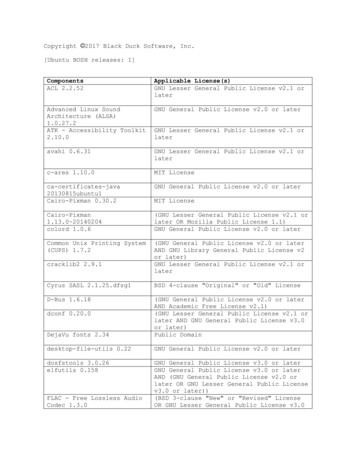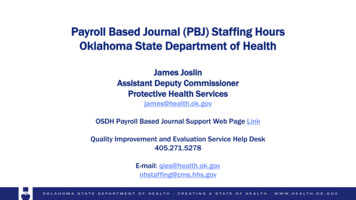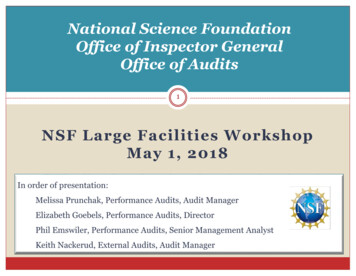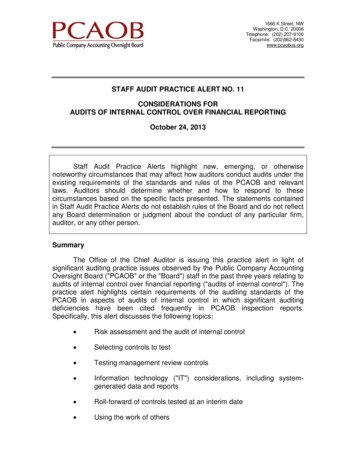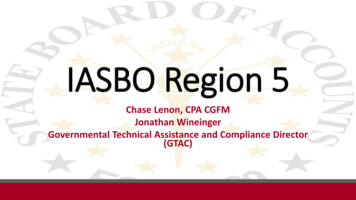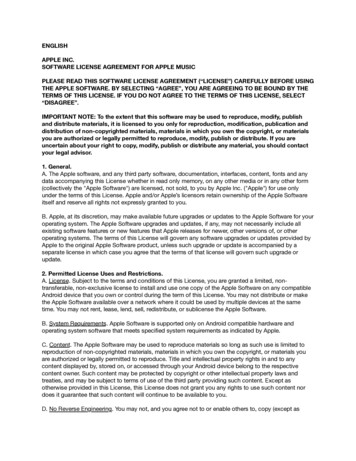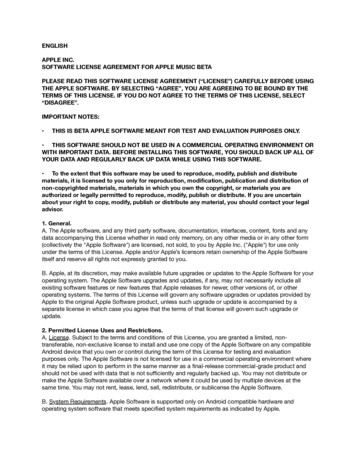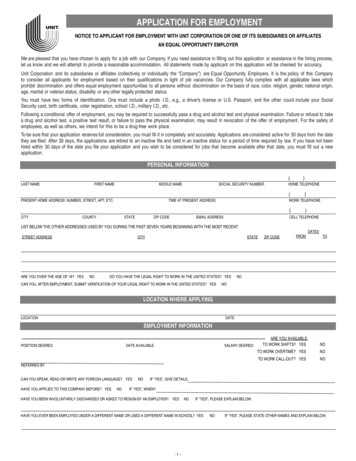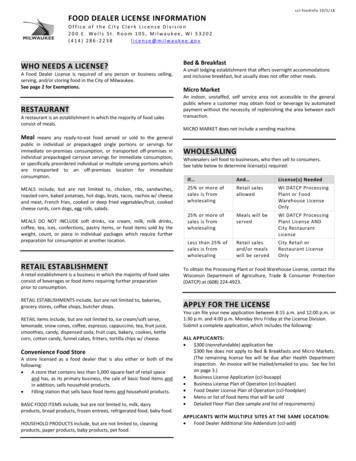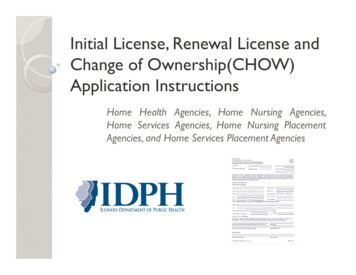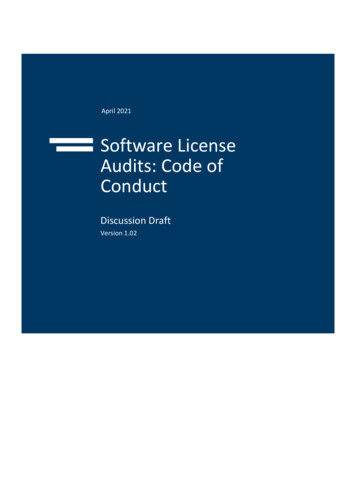
Transcription
April 2021Software LicenseAudits: Code ofConductDiscussion DraftVersion 1.02
Table of ContentsIntroduction . 4Scope . 5Objectives and Principles . 6Terminology . 7Code of Conduct . 8Audit Ethos . 8Clear Communications . 8Acting in Good Faith. 8Project Governance . 8Notification . 9Appointment of auditors . 9Scoping . 9Identification of Key Stakeholders . 9Planning. 9Managing the Audit . 10Entitlement Records . 10Consultants and Service Providers. 10Confidentiality during an Audit . 10Non-Disclosure Provisions . 11Confidentiality of Sensitive Data. 11Usage of Data . 11Data Security . 11Data Collection Utilities and Documentation . 11Data Collection . 11Scope of Data Collected from Customers . 12Use of Tools and Utilities . 12Act of Collection . 12Data Transmission . 13Completeness and Accuracy . 13Reporting and Audit Resolution. 13Report Format . 13
Factual Accuracy . 13Explanation of the Findings. 14Customer Feedback . 14This document represents an initial draft for discussion purposes. Comments can be sent tocode of conduct feedback@fticonsulting.com.If there is interest in developing this further it will need, at a minimum, input from publishers,customers and auditors, and their advisers. This input is required not just in respect of detaileddrafting but on the substantive issues of the balance of rights and obligations, the standing ofthe Code, how it might be kept up to date and what, if any, sanctions might be contemplatedfor non-compliance. We look forward to receiving comments on the draft and suggestions as tohow best to take this forward.Version control1.02 This version is made public for consultation.
Introduction1.Most software used by enterprises is licensed subject to terms which commonly include aright for the software publisher to conduct an audit of the customer’s compliance with thelicense. It has become increasingly common for publishers to invoke these rights, both on anad hoc, occasional basis, and on a programmatic basis. The number of such audits has grownsignificantly over the last 20 years and in any given year thousands of these audits take place.2.The license agreement is the source of the right to audit but this rarely sets out much detail asto the way in which the audit rights should be exercised. There is therefore considerablevariation in the approaches taken by publishers and customers to audits. Some audits areconducted by specialist teams within the publishers, but it is very common for publishers toappoint third-party auditors to conduct audits, some of whom may be subject to professionalstandards but many of whom are not.3.This variation creates difficulty for publishers, customers and auditors in conducting auditsconsistently in accordance with the terms of license agreements. Agreements vary in detail,publishers may approach things differently, customers’ software estates are very different,software products are licensed in different ways and all parties may have different attitudesto the expected rigour of the work, the acceptable time, cost and resource requirements andto privacy and similar matters. These expectation gaps can create significant tensionsbetween publisher and customer to the detriment of both parties.4.This code of conduct for software audits (“the Code of Conduct” or “the Code”) is intended tohelp alleviate this situation by clarifying expectations on all parties as to how a software auditshould be conducted. The Code is not intended to address the conduct of any parties to alicense agreement outside the specific context of a software audit.5.It reflects the views of publishers, customers and auditors. It is proposed to apply on avoluntary basis when both publisher and customer agree and to be in all respects subordinateto the specific terms set out in the license agreement.
Scope6.The Code of Conduct applies only to the exercise of software license audit rights by publishersin relation to their customers. It does not address conduct outside this specific context, forexample the sale or licensing of software or the ongoing management of software by eitherpublishers or their customers.7.Similarly, the Code does not apply to audits or reviews or inspections, however described,that are conducted other than under the terms of an audit clause, for example voluntaryaudits, self-declarations, requests for information outside an audit context.8.The Code does not apply when the entity which is subject to audit is not a customer of thepublisher, for example when an audit is conducted pursuant to allegations of software piracy.9.Within the context of a software audit, the Code sets out expectations on all parties to theaudit; these include: The publisher, including any in-house auditors The customer Any third-party auditors engaged by the publisher to conduct the audit (if applicable)10.Any third parties engaged by the customer to respond to the audit (if applicable)11.The Code of Conduct is subordinate to the rights set out in the licence agreement between apublisher and its customer.12.Compliance with the Code is voluntary. The Code will apply only if both the publisher and thecustomer agree at, or shortly after, notification of the audit by the publisher.13.If, during the audit, either party considers that the premises under which the parties chose tocomply with this Code of Conduct no longer apply then that party should notify the other tothis effect. The parties should discuss this and, absent any re-commitment to comply with theCode, the Code will no longer apply.
Objectives and PrinciplesObjectives14.The Code of Conduct aims to:Address customer concerns about the audit process.Promote greater certainty and consistency as to the audit approach taken by softwarepublishers, reducing the risks and costs for customers in responding.Enable smoother and more efficient audits at lower cost and with less disruption tocustomer relationships, making it easier for publishers to understand how their softwareis being consumed.Improve transparency and trust in the relationships between software publishers andtheir customers.Promote improvements in the conduct of software audits to the benefit of all parties.Principles15.An audit is a governance tool to enable a software publisher to satisfy itself that terms insoftware licences have been complied with by a customer. The information exchanged is tobe used only for that purpose.16.Audits are to be conducted in a fair and transparent manner on all sides and in accordancewith the licence agreement.17.The auditor’s role is to conduct the audit on behalf of the software publisher, which is itsclient. It is not the auditor’s role to provide advice to the customer. Nevertheless, there arebenefits to all parties from the greater understanding of license terms and use that flowsfrom an audit.18.The role of the third-party auditor is to be a fact finder; it is not the third-party auditor’s roleto determine the contractual terms of the software license agreements but it is entitled toproceed in accordance with its understanding of the terms.19.A necessary part of an audit is to establish a complete understanding of the usage of thepublisher’s software; this means that testing may be required in relation to devices, locationsand business units which the customer believes do not use the software publisher’s productsas well as those that do.
Terminology20.The following definitions are used in this Code of Conduct.Audit Compliance Audit Software Compliance Audit21.A project conducted to establish a reconciliation between software licenses owned andsoftware licences in use at a customer, and the customer’s compliance with the terms andconditions of those licences, in accordance with the terms of an audit clause in a softwarelicense agreement or other contract between the customer and software publisher.22.An audit in this Code is not the same as a financial or statutory audit, nor an internal audit forgovernance purposes.Software Publisher Publisher23.The party to the audit which is the licensor of the software being audited.Customer24.The party to the audit which is the licensee of the software being audited.Auditor25.The party to the audit which conducts the audit. This can either be:A third-party auditor which conducts the audit on the software publisher’s behalf, orAn in-house auditor employed by the software publisher.26.Where the term “auditor” is used in the document, both cases above are intended to beaddressed. Where distinction needs to be drawn, the terms “third-party auditor” or “in-houseauditor” are used.Consultants27.External parties engaged by the customer to be involved in the audit on a consulting basis, forexample to assist with data collection.Service Providers28.External parties engaged by the customer who provide services that are relevant to theactivities undertaken during the audit, such as hosting or IT estate management services.Service Providers may need to be involved in the audit to provide data.
Code of ConductAudit Ethos29.The aim of an audit is to calculate for those products, entities and geographies in scope acomplete30.and accurate view of the licenses owned and used by the customer (an “Effective LicensingPosition” or “ELP”), including whether the customer’s use complies with the terms andconditions of the license agreements. The report should be a complete and accurate view ofthe position at the time of the audit, with license requirements calculated, and use assessed,according to contractual terms.Clear Communications31.All parties should be clear and transparent in communications in respect of the audit.Acting in Good Faith32.The audit should be conducted in accordance with the terms of the license agreement and ina timely manner.33.Auditors should approach the audit as objective finders of fact.34.Customers should not seek to alter their usage of the publisher’s software after notificationof the audit so as to present a misleading or atypical impression of their use.35.A third-party auditor should disclose to both parties, in general terms, the relationshipswhich it has with the software publisher and the customer.36.The auditor should be prepared to explain its findings, in writing or face to face, to both thecustomer and the publisher.37.Where an auditor is subject to the standards of conduct of a professional or regulatory body,those standards should be adhered to in the conduct of the audit.Project Governance38.Setting accountability and ground rules for how the audit will be conducted is an importantstep to achieving an efficient process. Investing time in the planning and scoping of the audit,with a clear project plan accompanied by escalation routes, sets the tone for an effectiveaudit.
Notification39.An audit commences when the customer is formally notified by a software publisher underthe terms of an audit clause in a license agreement. Notifications must refer to, and be inaccordance with, the applicable clauses and should be in writing (including email).Appointment of auditors40.The auditor should meet all qualifications set out in the audit clause.Scoping41.The software publisher should clearly define the product, organisational and geographicscope of the audit at the outset, or as early in the process as possible. If products by thepublisher which were not contemplated in the initial scope discussions are unexpectedlyidentified during the audit, the software publisher should, after informing the customer, beentitled to extend the scope to include these.Identification of Key Stakeholders42.The software publisher should identify the person responsible for the audit, and their linemanager for escalation purposes.43.The software publisher should explain the role, if any, of the account team and of any reselleror partner which may be involved in the resolution of any audit findings.44.A third-party auditor should identify the lead for the work and their line manager forescalation purposes.45.The customer should identify the sponsor and project manager for the audit at the outset.The project manager should have sufficient seniority and knowledge of the organisation to beable to effectively manage the collection of data.46.The customer should identify any consultants appointed to advise the customer in relation tothe audit.Planning47.All parties should conduct the audit in line with the terms set out in the license agreementand the audit notification communication.48.All parties should come to a consensus on a project plan, with timeframes, at the start of theaudit. This should be documented in writing and should make clear the respectiveresponsibilities of the parties.49.The customer should make the software publisher and auditor aware of any business activityand known resource restrictions that may affect the audit at the outset of the audit, for
example planned change freezes, data centre migrations, planned annual leave of keycontacts. All parties should work collaboratively to minimise the impact of this activity on theaudit.Managing the Audit50.All parties should make every effort to meet the timeframes set out in the project plan and towork collaboratively to complete the audit within a reasonable timeframe and minimisingdisruption to the business of the customer.51.Customers should accept that resources, time and effort will be required to facilitate theaudit.52.The software publisher and auditor should be sensitive to the needs of the customer’sbusiness and to customer requests around resource availability and timescales.53.Clear escalation procedures should be established at the outset of the audit, on both thesoftware publisher and customer’s sides.Entitlement Records54.The software publisher should provide license entitlement records to the customer early inthe audit process to allow for review.55.The customer should review and validate the completeness of license entitlement recordsprovided by the software publisher or the auditor and work collaboratively to provideevidence of any additional entitlements held.Consultants and Service Providers56.Service Providers engaged by the customer to host IT infrastructure or any software withinthe scope of the audit should be identified by the customer. It is the customer’s responsibilityto facilitate the involvement of such Service Providers as may be necessary to enable thecustomer to fulfil its role in the audit.57.Consultants may be engaged by the customer to assist it during an audit. The customerremains responsible for any information provided by such consultants to the auditor and/orthe software publisher.Confidentiality during an Audit58.An audit can involve the collection and analysis of data that is considered confidential, withassociated concerns around the transmission, storage, access, and usage of that data. Thissection sets out some principles as to the collection and handling of confidential data.
Non-Disclosure Provisions59.Unless the license agreement otherwise addresses this, the customer may request that anythird-party auditor puts in place a non-disclosure agreement. No non-disclosure agreementwill be required with in-house auditors which will be covered by the obligations of the partiesin the license agreement.60.Where a separate non-disclosure agreement is required, the customer and the third-partyauditor should endeavour to agree the terms as quickly as possible.61.The customer should undertake that any Service Providers and Consultants that are assistingwith the audit are subject to the same confidentiality terms as the customer.Confidentiality of Sensitive Data62.The auditor should ensure that data that could be considered sensitive for privacy or securityreasons is redacted in the report prior to the release to the software publisher, unless agreedotherwise by the customer in writing.Usage of Data63.All parties should ensure that any data shared during an audit is only used for the purposes ofan audit.64.An in-house auditor will confine information received to the in-house audit team until theauditor’s report is finalised.Data Security65.All parties should ensure that sufficient controls are in place to ensure that confidential datacan only be accessed by individuals directly involved with the audit.Data Collection Utilities and Documentation66.The customer should ensure that any tools and/or documentation provided to assist with thedata collection are only used for the audit and are not distributed to other parties or used forany other purpose without the prior written consent of the party which provided the toolsand/or documentation.Data Collection67.The data requested as part of an audit should be rationalised and collected in the mostefficient manner possible: this may be an iterative process. Data already existing at thecustomer should be used as far as possible to minimise effort, but with adequate testing toensure completeness and accuracy. Where a customer does not have the necessary tools ordata to hand, utilities or methodologies provided by the publisher or auditor should be usedto fill the gaps.
Scope of Data Collected from Customers68.As far as possible, data collected should be limited to that which is relevant to the publisher’sprograms and licensing metrics and necessary for the audit. All parties should accept thatthere may be instances where incidental data is gathered that does not directly relate to thepublisher’s programs or licensing metrics. This should be treated as customer confidential.69.When collecting data, the auditor should be able to explain where requested the rationale forthe data required. The customer should not unreasonably withhold requested data, for whichthe rationale has been explained.70.Where the customer has data sources that already fulfil some or all the data pointsrequested, this should be used as far as possible.71.Data provided by the customer for the purposes of the audit should be tested forcompleteness and accuracy by the auditor. The customer should expect that if there are gapsin the completeness or accuracy of the data, additional work will be required to gathermissing information or to assess its likely significance.Use of Tools and Utilities72.Where the auditor requires tools or utilities to be run to collect data, and these tools orutilities do not form part of the software deployed by the customer, the customer should begiven adequate time to test the execution of these tools or utilities.73.When agreeing a project plan at the commencement of the audit, all parties should build insufficient time to allow testing of tools and utilities, taking guidance from the customerregarding relevant change control policies.74.The customer should endeavour to ensure that testing and change control formalities arecompleted as swiftly as possible.75.The customer should not unreasonably restrict the use of tools or utilities by the auditor.76.Where data is collected through tools and similar mechanisms, a copy of the data should beprovided to the customer.Act of Collection77.The auditor should not directly interact with the customer’s IT systems.78.The customer should cooperate with requests for data and provide the requested data in atimely manner, including provision of sufficient access to personnel.79.Where the auditor identifies that further data is required, the software publisher or auditorshould inform the customer of this additional requirement as soon as it becomes apparent.
The customer should cooperate with the requests from the software publisher or auditor toprovide any such additional data.Data Transmission80.Data should be transmitted between the customer, the auditor and the software publishervia means appropriate to the sensitivity of the data.Completeness and Accuracy81.All parties should take reasonable care to ensure that the data provided during the audit iscomplete and accurate.82.The auditor should be prepared to explain to the customer the reason for completeness andaccuracy testing on data provided by the customer, including data created following thesoftware publisher’s or auditor’s instructions.83.The auditor should be prepared to explain to the customer the steps taken to validate thecompleteness and accuracy of the data, as well as any material limitations to the testing.Reporting and Audit Resolution84.The report can have significant financial consequences for customers and publishers; itshould be clear how data has been used to draw conclusions, and customers should have theopportunity to check the facts before submission to the software publisher.Report Format85.The auditor’s report should be clear, accurate and easily understood to enable the publisherand the customer to understand the position.86.Assumptions should be clearly stated in the auditor’s report.87.The software publisher or the auditor should ensure that when producing a report, theresulting license position is clearly linked to the source data to allow for efficient and timelyreview of the report by the customer.88.If the audit report includes any data which has been extrapolated, the report should describethe approach to extrapolation and the assumptions upon which it is based, as well as theeffect of the extrapolation on the resulting numbers.Factual Accuracy89.The software publisher should allow the customer adequate time to review and providecommentary on the factual accuracy of the report and allow for a right of reply.
90.The auditor should provide the customer with the opportunity to provide feedback/points ofmitigation, preferably throughout the course of the audit, or allow adequate time afterdelivery of the report.91.The customer should endeavour to review the report and provide feedback within the periodallocated by the software publisher.Explanation of the Findings92.The auditor should be prepared to explain the audit findings to the customer, including theaudit methodology.Customer Feedback93.A third-party auditor should ensure that any commentary that the customer requests to beincluded on any items in the audit report are included in the final report to the publisher.
DAVID EASTWOODSenior Managing Director 44 7802 636079david.eastwood@fticonsulting.comGARETH COFFEYSenior Director 44 7976 989060gareth.coffey@fticonsulting.comANDY JACKSONSenior Director 44 7970 202566andy.jackson@fticonsulting.comFTI FTIConsultingis anindependentglobalto gechange,change,Consultingis yfirmfirm dedicateddedicated tomitigate risk and resolve disputes: financial, legal,mitigaterisk andpoliticalresolve&disputes:financial,legal, atedand ransactional.FTI &Consultingprofessionals,in all major business centres throughout the world, work closelyFTI withConsultinglocated in andall majorbusinesscentersthroughoutthe world,work closely 2021with clientstoclientsprofessionals,to anticipate, illuminateovercomecomplexbusinesschallengesand opportunities.FTI Consulting,Inc. All rights reserved. Connect with us onTwitter illuminate(@FTIConsulting),Facebookand LinkedIn.anticipate,and nges and opportunities. 2021 FTI Consulting, Inc. All rights reserved. www.fticonsulting.com
license agreement or other contract between the customer and software publisher. 22. An audit in this Code is not the same as a financial or statutory audit, nor an internal audit for governance purposes. Software Publisher Publisher 23. The party to the audit which is the licensor of the software being audited. Customer 24. The party to the .
